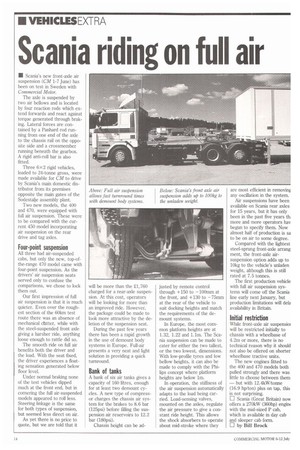Scania riding on full air
Page 16

If you've noticed an error in this article please click here to report it so we can fix it.
• Scania's new front-axle air suspension (CM 1-7 June) has been on test in Sweden with Commercial Motor.
The axle is suspended by two air bellows and is located by four reaction rods which extend forwards and react against torque generated through braking. Lateral forces are contained by a Panhard rod running from one end of the axle to the chassis rail on the opposite side and a crossmember running beneath the gearbox. A rigid anti-roll bar is also fitted.
Three 6x2 rigid vehicles, loaded to 24-tonne gross, were made available for CM to drive by Scania's main domestic distributor from its premises opposite the main gates of the Sodestalje assembly plant.
Two new models, the 400 and 470, were equipped with full air suspension. These were to be compared with the current 450 model incorporating air suspension on the rear drive and tag axles.
Four-point suspension
All three had air-suspended cabs, but only the new, top-ofthe-range 470 model came with four-point suspension. As the drivers' air suspension seats served only to confuse the comparisons, we chose to lock them out.
Our first impression of full air suspension is that it is much quieter. Even over the roughest section of the 60km test route there was an absence of mechanical dater, while with the steel-suspended front axle giving a harsher ride, anything loose enough to rattle did so.
The smooth ride on full air benefits both the driver and the load. With the seat fixed, the driver experiences a floating sensation generated below floor level.
Under normal braking none of the test vehicles dipped much at the front end, but in cornering the full air-suspended models appeared to roll less. Steering linkage is the same for both types of suspension, but seemed less direct on air.
As yet there is no price to quote, but we are told that it will be more than the £1,760 charged for a rear-axle suspension. At this cost, operators will be looking for more than an improved ride. However, the package could be made to look more attractive by the deletion of the suspension seat.
During the past few years there has been a rapid growth in the use of demount body systems in Europe. Full-air presents a very neat and light solution in providing a quick turnround.
Bank of tanks
A bank of six air tanks gives a capacity of 160 litres, enough for at least two demount cycles. A new type of compressor charges the chassis air system for the brakes to 8.6 bar (125psi) before filling the suspension air reservoirs to 12.2 bar (180psi).
Chassis height can be ad justed by remote control through +150 to –100mm at the front, and +130 to –75mm at the rear of the vehicle to suit docking heights and match the requirements of the demount systems.
In Europe, the most common platform heights are at 1.32, 1.22 and 1.1m. The Scania suspension can be made to cater for either the two tallest, or the two lowest, dimensions. With low-profile tyres and low bellow heights, it can also be made to comply with the Philips concept where platform heights are below lm.
In operation, the stiffness of the air suspension automatically adapts to the load being carried. Load-sensing valves, mounted on the axles, regulate the air pressure to give a constant ride height. This allows the shock absorbers to operate about mid-stroke where they are most efficient in removirq any oscillation in the system.
Air suspensions have been available on Scania rear axles for 15 years, but it has only been in the past five years th; more and more operators hay begun to specify them. Now almost half of production is sa to be on air to some degree.
Compared with the lightest steel-sprung front-axle arrang ment, the front-axle airsuspension option adds up to 10kg to the vehicle's unladen weight, although this is still rated at 7.5 tonnes.
The first production vehicle with full air suspension systems will come off the Scania line early next January, but production limitations will dela availability in Britain.
Initial restriction
While front-axle air suspensioi will be restricted initially to chassis with a wheelbase of 4.2m or more, there is no technical reason why it should not also be offered on shorter wheelbase tractive units.
The new engines fitted to the 400 and 470 models both pulled strongly and there was little to choose between them — but with 12.4kW/tonne (16.9 hp/ton) plus on tap, this is not surprising. 111 Scania (Great Britain) now offers a 270kW (360hp) engin( with the mid-sized P cab, which is available in day cab and sleeper cab form.
CI by Bill Brock




















































































































